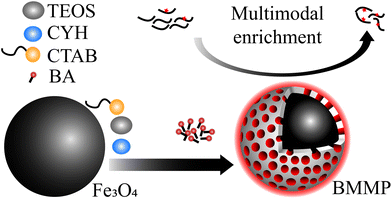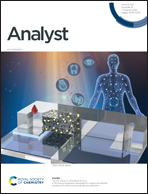Boronic acid-functionalized mesoporous magnetic particles with a hydrophilic surface for the multimodal enrichment of glycopeptides for glycoproteomics†
Abstract
Glycosylation is an important mechanism of secondary protein processing. Large-scale profiling of glycopeptides released by proteolytic digestion of glycoproteins from biologic samples with complex compositions is limited due to their low abundance. Herein, we present a multimodal material based on boronic acid-modified mesoporous magnetic particles with a hydrophilic surface and enlarged pores around 10 nm. Multimodal enrichment successfully improved the enrichment specificity and efficiency of BMMP by synergistic interaction of hydrophilicity and boronic acid functional groups. The 10 nm pore size allows glycopeptides to enter the channel. Hydrophilic glycopeptides could be selectively enriched with an extremely low limit of detection (0.33 fmol per μL) and a high selectivity (1 : 100). From 2 μL of human serum, 328 unique glycopeptides from 101 glycoproteins were identified. A total of 33% of those glycoproteins overlapped with FDA-cleared blood serum biomarkers. It is expected that BMMP in the future can be used for large-scale biomedical glycoproteomics studies.



 Please wait while we load your content...
Please wait while we load your content...